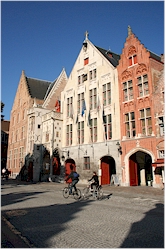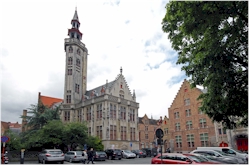|
Picture: Jan Van Eyckplein |
|
» Eating » Sleeping facilities » Going out in Bruges » Fixed events » Beguinage » Belfry and halls » Chapel of the Holy Blood » Court of the Princes » Dunes abbey » Guild houses of Bruges » Hospices of Bruges » Jerusalem church » Nation houses » Our Ladies church » Poortersloge » St-Anna's church » St-Donatian's cathedral » St-John's hospital » St-Saviour's cathedral » Town gates » Town hall » Windmills of Bruges » Complete overview... » Archeology museum » Brangwyn museum » Brewery museum » Chocolate museum » Diamant museum » Folklore museum » Frites museum » Groeninghe museum » Guido Gezelle museum » Halve Maan » Lace museum » Lamps museum » Memling museum » Museum of Fine Arts » Salvador Dali museum » St-Janshuismill » St-John's hospital » Complete overview... » Boterhuis » Boudewijn Seapark » Burg » Canals (Reien) » Coupure » De Garre » Grote Markt » Historium » Huidevettersplein » Jan Van Eyckplein » Lake of Love (Minnewater) » Rozenhoedkaai » Simon Stevinplein » 't Zand » Complete overview... |
Van Eyck square (Van Eyckplein) General. Although this square is close to the Grote Markt, it is slightly outside the traditional tourist route. You will find it is much calmer than the Burg or Markt. Nevertheless it is one of the nicest places in Bruges. Here most of the port activity took place. Ships from all corners of Europe docked here to be loaded or unloaded. It is no surprise that all the most important nationhouses and warehouses were in the immediate vicinity. Many ancient houses stand here in harmony together around the square.
Poortersloge. The Poortersloge is the most remarkable building on the square. It has a slender tower and its facade is adorned with several statues, under which "het beertje van de loge" (the bear of the loggia). It was built at the end of the 14th and beginning of the 15th century. More information on a separate page [click here]. Tolhuis. The toll house is actually not one house but a complex of four premises dating back to the beginning of the 13th century. Initially trade houses, they became the "Big Toll" somewhere in the beginning of the 14th century. Here the goods that arrived in Bruges had to be weighed and cleared for taxation. The actual toll house is the big one in natural grey stone. The richly decorated little house to its left is the house of the "Pijnders", the porters who were in charge of (un)loading freight. Nowadays, the house serves as provincial information desk and library. De Rode Steen. The large house on the corner of the Spiegelrei and Genthof was called the Red Stone. In its core it goes back to the 13th century.
Picture 1: The "Tolhuis"
|
» getting to Bruges » transport, tours, links,...
|
|
© xplorengo.com. Information is provided from the location and various sources, we do not hold any responsibility with regard to information provided by others. xplorengo is not a travel agency and does not promote or organize trips we therefore hold no responsibility with regard to third parties that promote their services via us. No information or pictures can be copied or distributed in any way without written permission of xplorengo.com. All pictures are made and copyrighted by Hendrik De Leyn unless mentioned otherwise [Contact information]. |
 Brief history.
This place didn't always use to be a square. It was
created at the end of the 18th century when most harbour
activity here was at its end. The Spiegelrei (canal) used
to run where the square is nowadays and was connected with the
Dijver behind the Burg square. When the canal was filled
up, it made space available for the square. It was named
after the famous artist Jan van Eyck, for whom a statue was
erected.
Brief history.
This place didn't always use to be a square. It was
created at the end of the 18th century when most harbour
activity here was at its end. The Spiegelrei (canal) used
to run where the square is nowadays and was connected with the
Dijver behind the Burg square. When the canal was filled
up, it made space available for the square. It was named
after the famous artist Jan van Eyck, for whom a statue was
erected.
